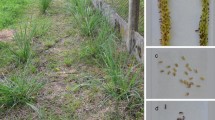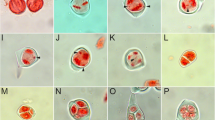Abstract
Apomictic seed development in dandelion (Taraxacum officinale) involves (1) restitutional meiosis (diplospory), (2) egg cell parthenogenesis, and (3) autonomous endosperm development. The question is whether these elements of apomixis are controlled by one single gene or by several independent genes. Five triploid non-apomictic hybrids, obtained in diploid sexual × triploid apomict crosses were characterized using cyto-embryological and genetic methods. Nomarski-differential interference contrast microscopy and the transmission of microsatellite markers and ploidy levels indicated that the hybrids combined elements of the apomictic and the sexual developmental pathway. Hybrids form two complementary groups with respect to the presence or absence of parthenogenesis and autonomous endosperm development. The occurrence of complementary apomixis-recombinants suggests that parthenogenesis and autonomous endosperm development in Taraxacum are regulated independently by different genes. This study also indicates that early embryo development is independent of endosperm formation, but that endosperm is essential for later embryo growth.



Similar content being viewed by others
References
Asker SE, Jerling L (1992) Apomixis in plants. CRC Press, Boca Raton, Fla.
Bicknell R, Borst NK, Koltunow AM (2000) Monogenic inheritance of apomixis in two Hieracium species with distinct developmental mechanisms. Heredity 84:228–237
Chaudhury AM, Ming L, Miller C, Craig S, Dennis ES, Peacock WJ (1997) Fertilization-independent seed development in Arabidopsis thaliana. Proc Natl Acad Sci USA 94:4223–4228
Cooper DC, Brink RA (1949) The endosperm-embryo relationship in an autonomous apomict, Taraxacum officinale. Bot Gaz 111:139–153
Falque M, Keurentjes J, Bakx-Schotman JMT, Van Dijk PJ (1998) Development and characterization of microsatellite markers in the sexual-apomictic complex Taraxacum officinale (dandelion). Theor Appl Genet 97:283–292
Grossniklaus U, Vielle-Calzada J-P, Hoeppner MA, Gagliano WB (1998) Maternal control of embryogenesis by MEDEA, a polycomb-group gene in Arabidopsis. Science 280:446–450
Gustafsson Å (1947a) Apomixis in angiosperms II. Lunds Univ Årsskr Avd 2 42:71–179
Gustafsson Å (1947b) Apomixis in angiosperms III. Lunds Univ Årsskr Avd 2 43:183–370
Harlan JR, DeWet JMJ (1975) On Ö. Winge and a prayer: The origins of polyploidy. Bot Rev 41:361–390
Koltunow AM (1993) Apomixis: embryo sacs and embryos formed without meiosis or fertilization in ovules. Plant Cell 5:1425–1437
Mogie M (1988) A model for the evolution and control of generative apomixis. Biol J Linn Soc 35:127–153
Mogie M (1992) The evolution of asexual reproduction in plants. Chapman and Hall, London
Nawaschin S (1898) Resultate einer revision der befruchungsvorgänge bei Lilium martagon und Fritillaria tenella. Bull Sci Acad Imp Sci St.-Petersbourg 33:39–47
Nogler GA (1984) Gametophytic apomixis. In: Johri BM (ed) Embryology of angiosperms. Springer, Berlin Heidelberg New York, pp 475–518
Noyes RD, Rieseberg LH (2000) Two independent loci control agamospermy (apomixis) in the triploid flowering plant Erigeron annuus. Genetics 155:379–390
Ohad N, Margossian L, Hsu YC, Williams C, Repetti P, Fischer RL (1996) A mutation that allows endosperm development without fertilization. Proc Natl Acad Sci USA 93:5319–5324
Richards AJ (1970) Eutriploid facultative agamospermy in Taraxacum. New Phytol 69:761–774
Richards AJ (1973) The origin of Taraxacum agamospecies. Bot J Linn Soc 66:189–211
Rogstad SH (1992) Saturated NaCl-CTAB solutions as a means of field preservation of leaves for DNA analyses. Taxon 41:701–708
Sherwood RT (2001) Genetic analysis of apomixis. In: Savidan Y, Carman JG, Dresselhaus T (eds) The flowering of apomixis: from mechanisms to genetic engineering. CIMMYT, IRD, European Commission DG VI (FAIR), Mexico, pp 64–82
Sørensen T (1958) Sexual chromosome-aberrants in triploid apomictic Taraxaca. Bot Tidskr 54:1–22
Sørensen T, Gudjónsson, G (1946) Spontaneous chromosome-aberrants in triploid apomictic Taraxaca. K Dan Vidensk Selsk Biol Skr 4:3–48
Stebbins GL (1950) Variation and evolution in plants. Columbia University Press, New York
Tas ICQ, Van Dijk PJ (1999) Crosses between sexual and apomictic dandelions (Taraxacum). I. The inheritance of apomixis. Heredity 83:707–714
Van Baarlen P, van Dijk PJ, Hoekstra RF, De Jong JH (2000) Meiotic recombination in sexual diploid and apomictic triploid dandelions (Taraxacum officinale L.). Genome 43:827–835
Van Baarlen P, De Jong JH, Van Dijk PJ (2002) Comparative cyto-embryological investigations of sexual and apomictic dandelions (Taraxacum) and their apomictic hybrids. Sex Plant Reprod 15:31–38
Van Dijk PJ, Van Damme JMM (2000) Apomixis-technology and the paradox of sex. Trends Plant Sci 5:81–84
Van Dijk PJ, Tas ICQ, Falque M, Bakx-Schotman JMT (1999) Crosses between sexual and apomictic dandelions (Taraxacum). II. The breakdown of apomixis. Heredity 83:715–721
Vielle-Calzada J-P, Crane CF, Stelly DM (1996) Apomixis. The asexual revolution. Science 274:1322–1323
Willemse MTM, Van Went JL (1984) The female gametophyte. In: Johri BM (ed) Embryology of angiosperms. Springer, Berlin Heidelberg New York, pp 156–196
Acknowledgement
We thank Tanja Bakx-Schotman for technical assistance.
Author information
Authors and Affiliations
Corresponding author
Additional information
P.J. van Dijk and P. van Baarlen contributed equally to this paper. Publication 3136 NIOO-KNAW Netherlands Institute of Ecology
Rights and permissions
About this article
Cite this article
van Dijk, P.J., van Baarlen, P. & de Jong, J.H. The occurrence of phenotypically complementary apomixis-recombinants in crosses between sexual and apomictic dandelions (Taraxacum officinale). Sex Plant Reprod 16, 71–76 (2003). https://doi.org/10.1007/s00497-003-0177-5
Received:
Accepted:
Published:
Issue Date:
DOI: https://doi.org/10.1007/s00497-003-0177-5




